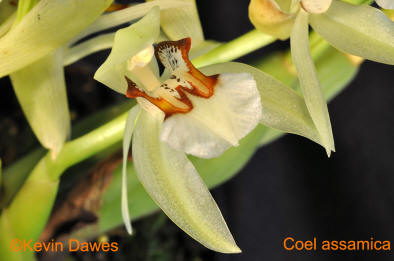Coelogyne assamica
Although not readily available or well-known, Coelogyne assamica rightly deserves recognition among orchid hobbyists and not just collectors. It has clear and attractive markings and hails from Bhutan, Northeast India (hence the epithet after Assam), Burma, China, Loas, Vietnam and Thailand. It grows in relatively low (700m) and humid areas along river valleys as an ephiphyte.
Coelogyne assamica is probably the best of a group of similar-looking Coelogynes that include fuscescens, marmorata and triplicatula. It usually has eight good size flowers (7 cm+) per inflorescence, which are long lasting, opening simultaneously and they have nice clear markings on a compact, intermediate size, clumping plant. The flowers open a soft apple green colour and fade to whitish with age. It is hardy and easy to grow in intermediate conditions but is very intolerant of cold weather.
Cultivation Suggestions: Avoid frosts completely - it doesn't like getting below about 150C. Because of its origins you will need to provide partial shade, high humidity and water well. The flower spikes are slightly below the broad-leaf canopy and although semi-erect, they are slightly hidden. This can be overcome by placing the plant in a slightly raised position - hanging on the wall or on a pedestal or in a low hanging basket.
As with most of my orchids, I bring them inside the house while they are flowering so that they can be admired to the maximum. As soon as the flowers start to get past their peak, I return them to the orchid house.
As with all Coelogynes, I like to give them a small dose of slow release fertiliser (whatever you get your hands on) at the start of spring and again at the start of autumn.
Negatives: It is not very easy to obtain. When you do get one you will find few negatives if you live in a warm area. If the temperature drops below 150C it is likely to drop its leaves and if it is too damp at this time it will die.
Rating: ♦♦♦♦
Sometimes sold as: fuscescens var assamica, siamensis, dalatensis, or saigonensis
Varieties: None known
Hybrids:
1. Coelogyne Kirribilli Lynette using Coel speciosa as the pod parent - (Kevin Dawes 2013)
2. Coelogyne Kirribilli Ellen using Coel mooreana 'Brockhurst' as the pod parent - (Kevin Dawes 2014)
3. Coelogyne Kirribilli Danielle - (Kevin Dawes 2014) using Coelogyne usitana as the pod parent.
4. Coelogyne Green Elf - (Naresh 2018) usingCoelogyne fuscescens as the pod parent.
| Coel barbata > |

